Bench scale apparatus to model and develop biopharmaceutical cleaning procedures
a biopharmaceutical and bench-scale technology, applied in the direction of chemistry apparatus and processes, instruments, material analysis, etc., can solve the problems of insufficient exemplification of conditions in the cleaning procedures typically used on the coupons, time-consuming and impractical production equipment, and difficult questions affecting the fundamental components of cleaning details
- Summary
- Abstract
- Description
- Claims
- Application Information
AI Technical Summary
Benefits of technology
Problems solved by technology
Method used
Image
Examples
example 1
[0071]The Last2Rinse was implemented to investigate the cleanability of various soils from several commonly used MOC coupons: Stainless Steel (SS), Glass, Polymethylpentene (PMP), Silicone, Acrylic, TEFLON (polvtetrafluorethvlene), Polypropylene (PolyPro), and Ethylene-Propylene-Diene Monomer (EPDM). Triplicate coupons of these MOC were soiled with 1 ml of six different soiling solutions. These soiling solutions were allowed to dry on the coupons for eight hours in an incubator at 37° C. To clean the MOC coupons, five cleaning cycles, A though E, were implemented (Table 3). Coupons were exposed to a maximum of 300 seconds of each cleaning cycle; each cycle was more aggressive than the previous one. A calibrated stopwatch was used to time the cycles. When coupons were visually clean, they were removed from the apparatus and swabbed for residual TOC. If coupons were not deemed visually clean upon a completion of a 300 second cycle, they were exposed to the next most aggressive cleanin...
example 2
Empirical Assessment of “Worst Case” Challenge Soil Selections
[0075]The results in FIG. 5 also include an empirical demonstration of choosing a cleaning validation “worst case” challenge soiling solution. The soiling solutions in this experiment were chosen on the basis of component number, complexity, concentration, solubility and viscosity. These solutions were given a cleanability rating (i.e., Total Matrix Value) utilizing the semi-quantitation matrix approach described above (see Table 4). Table 5 summarizes the soil types investigated with respect to their total matrix value and observed cleaning times. The results clearly indicate that the low component buffer with a highly hydrophobic (non-aqueous organic) component took the longest time to come visually clean on any MOC surface. The high component / high concentration media was the next most difficult to clean, followed by the low component / high concentration buffer. The low component / low concentration buffer and low componen...
example 3
Sample Calculation of an Example Soil Using the Challenge Semi-Quantitation Matrix
[0077]Buffer XYZ from “Acme” Buffer Suppliers has the following components:
[0078]
.020 M MESAqueous Soluble Organic(2.62 g / L MES-acid + 1.45 g / LMES-base = 4.07 g / L)0.020 M CaCl2Divalent Salt(2.94 g / L)0.1% V-Tween-80Aqueous Soluble Organic(1.0 mL / L × a density of 1.1 g / mL =1.1 g / L)1 M NaClMonovalent Salt (58.4 g / L)(58.4 g / L)0.020 M L-HistidineAmino Acid (3.1 g / L)(3.1 g / L)
Both MES and V-Tween-80 are categorized as “Aqueous Soluble Organics” and therefore their gram weights are added together (4.07 g / L MES+1.1 g / L Tween=5.17 g / L or ≧4 g / L of Aqueous Soluble Organics in the Concentration Dependent Multiplier). Acme calls for bringing the pH of the solution to pH 6.0 with 2.0 mL / L of concentrated HCl, therefore, an Acid component is also accounted for in the Matrix. The Matrix, with highlighted cells showing the place of each component on the table, is shown in Table 6; the final semi-quantitation value is B...
PUM
| Property | Measurement | Unit |
|---|---|---|
| angle | aaaaa | aaaaa |
| temperature | aaaaa | aaaaa |
| pressures | aaaaa | aaaaa |
Abstract
Description
Claims
Application Information
 Login to View More
Login to View More - R&D
- Intellectual Property
- Life Sciences
- Materials
- Tech Scout
- Unparalleled Data Quality
- Higher Quality Content
- 60% Fewer Hallucinations
Browse by: Latest US Patents, China's latest patents, Technical Efficacy Thesaurus, Application Domain, Technology Topic, Popular Technical Reports.
© 2025 PatSnap. All rights reserved.Legal|Privacy policy|Modern Slavery Act Transparency Statement|Sitemap|About US| Contact US: help@patsnap.com



